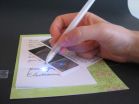Insight into plant behavior could aid quest for efficient biofuels
Tiny seawater algae could hold the key to crops as a source of fuel and plants that can adapt to changing climates
2011-06-28
(Press-News.org) Tiny seawater algae could hold the key to crops as a source of fuel and plants that can adapt to changing climates.
Researchers at the University of Edinburgh have found that the tiny organism has developed coping mechanisms for when its main food source is in short supply.
Understanding these processes will help scientists develop crops that can survive when nutrients are scarce and to grow high-yield plants for use as biofuels.
The alga normally feeds by ingesting nitrogen from surrounding seawater but, when levels are low, it reduces its intake and instead absorbs other nutrients, such as carbon and phosphorus, from the water. The organism is also able to recycle nitrogen from its own body, breaking down proteins that are plentiful to make other proteins that it needs to survive.
Nitrogen is needed by all plants to survive but the alga's survival strategies vary from most other plants which, when nitrogen is scarce, tend to widen their search for it.
Like many organisms, the alga – Ostreococcus tauri – is also driven by daylight and its body clock – for example, proteins that produce starch for food are active in the evening, after the plant has photosynthesised sugars from sunlight in the day.
The study, in the Journal of Proteomics, was funded by the Biotechnology and Biological Sciences Research Council and the Engineering and Physical Sciences Research Council.
Dr Sarah Martin, of the University of Edinburgh, who took part in the study, said: "This tiny alga certainly punches above its weight when it comes to survival. Our study has revealed some curious ways in which the organism finds the nutrients it needs to stay alive – tricks like these could be useful to us in developing sustainable crops for the future."
INFORMATION: END
ELSE PRESS RELEASES FROM THIS DATE:
2011-06-28
Tampa, Fla. (June 28, 2011) – Mensenchymal stem cells (MSCs), multipotent cells identified in bone marrow and other tissues, have been shown to be therapeutically effective in the immunosuppression of T-cells, the regeneration of blood vessels, assisting in skin wound healing, and suppressing chronic airway inflammation in some asthma cases. Typically, when MSCs are being prepared for therapeutic applications, they are cultured in fetal bovine serum.
A study conducted by a research team from Singapore and published in the current issue of Cell Medicine [2(1)], freely ...
2011-06-28
In another world first, Australian Company JetBoarder pioneers the way in the new sport of JetBoarding. Their newest model, which previewed at Sanctuary Cove International Boat Show in Australia, is a real world first.
Click link to see more: http://vimeo.com/24210179
Called the 'Sprint', the focus with the kids' JetBoarder was safety first and fun second, in a new experience for kids aged 12-16. Our SPRINT Model achieves this plus more advises Chris Kanyaro. "We want to give kids the opportunity to enjoy the latest craze taking the world by storm" in ...
2011-06-28
For Hollywood celebrities, the term "splitsville" usually means "check your prenup." For scientists wanting to mass-produce high quality nanoribbons from boron nitride nanotubes, "splitsville" could mean "happily ever after."
Scientists with the Lawrence Berkeley National Laboratory (Berkeley Lab) and the University of California (UC) Berkeley, working with scientists at Rice University, have developed a technique in which boron nitride nanotubes are stuffed with atoms of potassium until the tubes split open along a longitudinal seam. This creates defect-free boron nitride ...
2011-06-28
TORONTO, Ont., June 28, 2011—A chemical produced by the same cells that make insulin in the pancreas prevented and even reversed Type 1 diabetes in mice, researchers at St. Michael's Hospital have found.
Type 1 diabetes, formerly known as juvenile diabetes, is characterized by the immune system's destruction of the beta cells in the pancreas that make and secrete insulin. As a result, the body makes little or no insulin.
The only conventional treatment for Type 1 diabetes is insulin injection, but insulin is not a cure as it does not prevent or reverse the loss of ...
2011-06-28
EVANSTON, Ill. --- To many, a tax on soda is a no-brainer in advancing the nation's war on obesity. Advocates point to a number of studies in recent years that conclude that sugary drinks have a lot to do with why Americans are getting fatter.
But obese people tend to drink diet sodas, and therefore taxing soft drinks with added sugar or other sweeteners is not a good weapon in combating obesity, according to a new Northwestern University study.
An amendment to Illinois Senate Bill 396 would add a penny an ounce to the cost of most soft drinks with added sugar or sweeteners, ...
2011-06-28
CORVALLIS, Ore. – Inkjet printers, a low-cost technology that in recent decades has revolutionized home and small office printing, may soon offer similar benefits for the future of solar energy.
Engineers at Oregon State University have discovered a way for the first time to create successful "CIGS" solar devices with inkjet printing, in work that reduces raw material waste by 90 percent and will significantly lower the cost of producing solar energy cells with some very promising compounds.
High performing, rapidly produced, ultra-low cost, thin film solar electronics ...
2011-06-28
CHAMPAIGN, Ill. — The pen may have bested the sword long ago, but now it's challenging wires and soldering irons.
University of Illinois engineers have developed a silver-inked rollerball pen capable of writing electrical circuits and interconnects on paper, wood and other surfaces. The pen is writing whole new chapters in low-cost, flexible and disposable electronics.
Led by Jennifer Lewis, the Hans Thurnauer professor of materials science and engineering at the U. of I., and Jennifer Bernhard, a professor of electrical and computer engineering, the team published ...
2011-06-28
Stepladders, a household product used by thousands of people every day, are a surprisingly common cause of injury. In 2009, more than 187,000 Americans visited the hospital after sustaining stepladder injuries, many of which resulted from a fall. A recent human factors/ergonomics study explores how improved design and user behavior can decrease the likelihood of future accidents.
In their upcoming HFES 55th Annual Meeting presentation, "The Role of Human Balance in Stepladder Accidents," HF/E researchers Daniel Tichon, Lowell Baker, and Irving Ojalvo review research ...
2011-06-28
Cambridge, Mass. - June 28, 2011 - At a glance, a painting by Jackson Pollock (1912) can look deceptively accidental: just a quick flick of color on a canvas.
A quantitative analysis of Pollock's streams, drips, and coils, by Harvard mathematician L. Mahadevan and collaborators at Boston College, reveals, however, that the artist had to be slow—he had to be deliberate—to exploit fluid dynamics in the way that he did.
The finding, published in Physics Today, represents a rare collision between mathematics, physics, and art history, providing new insight into ...
2011-06-28
Grand Rapids, Mich. (June 28, 2011) – Most of us have had a doctor prescribe an antibiotic for a stubborn bacterial infection, or for a cut that gets infected. However, prescribing an antibiotic to fight cancer? In fact, anti-cancer antibiotics have been used since the 1950s to successfully treat several forms of cancer, but often the side effects limit the duration they can be given to a patient.
One particularly promising anti-cancer antibiotic is Geldanamycin and a modified form of this drug known as 17AAG. Despite its proven ability to selectively kill many ...
LAST 30 PRESS RELEASES:
[Press-News.org] Insight into plant behavior could aid quest for efficient biofuels
Tiny seawater algae could hold the key to crops as a source of fuel and plants that can adapt to changing climates


